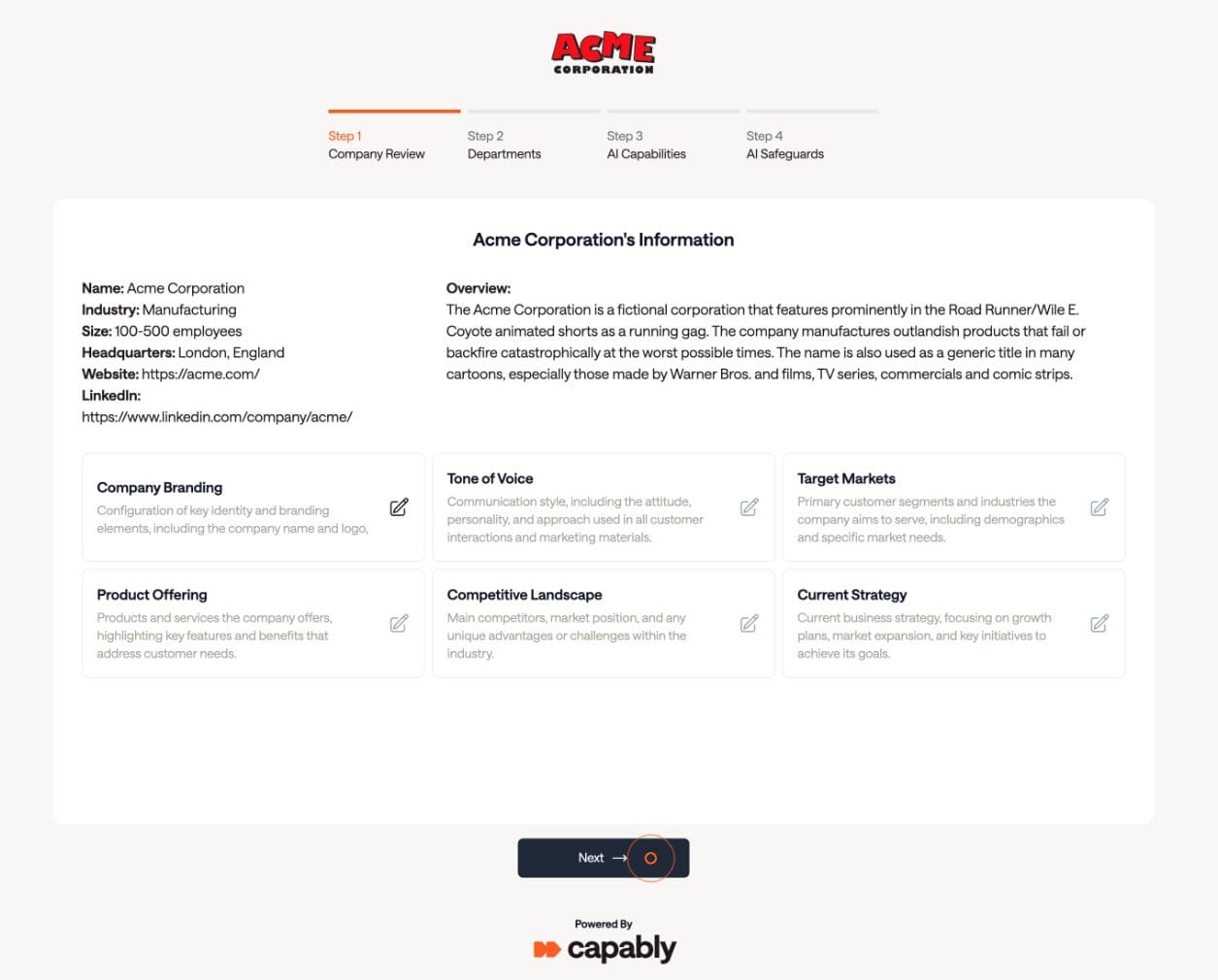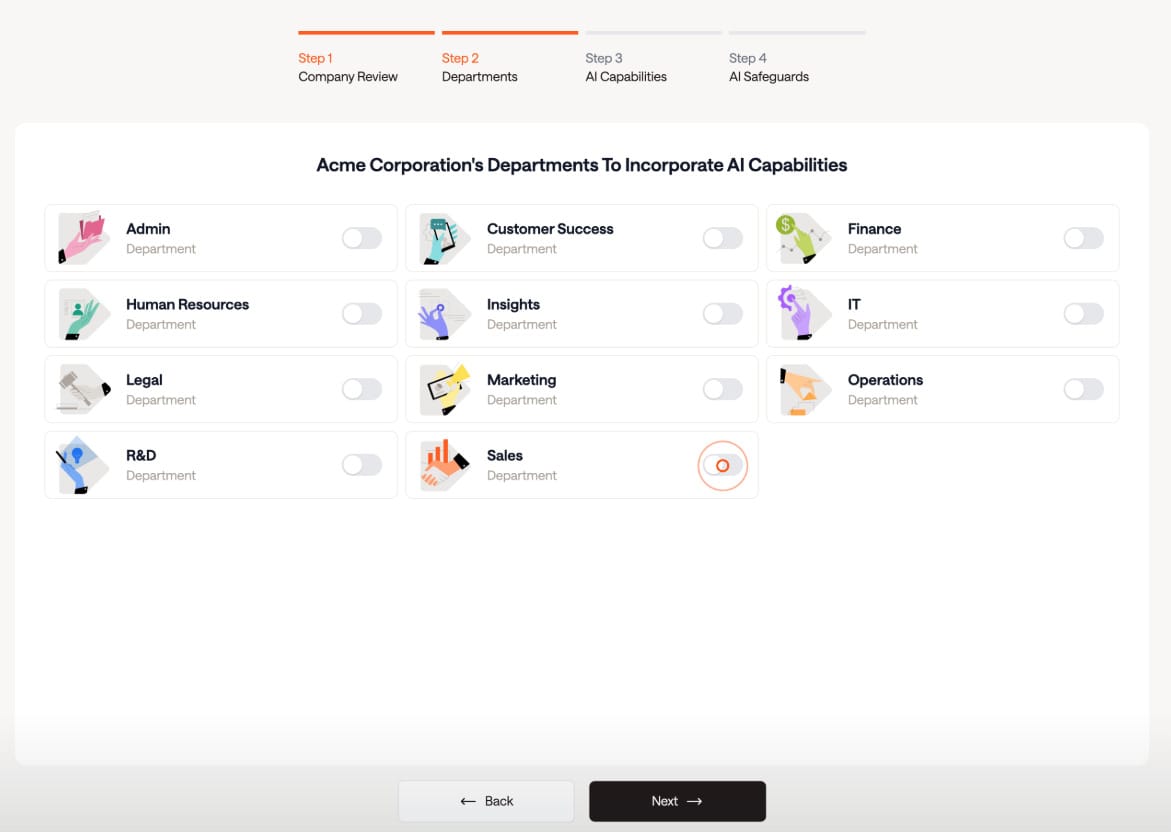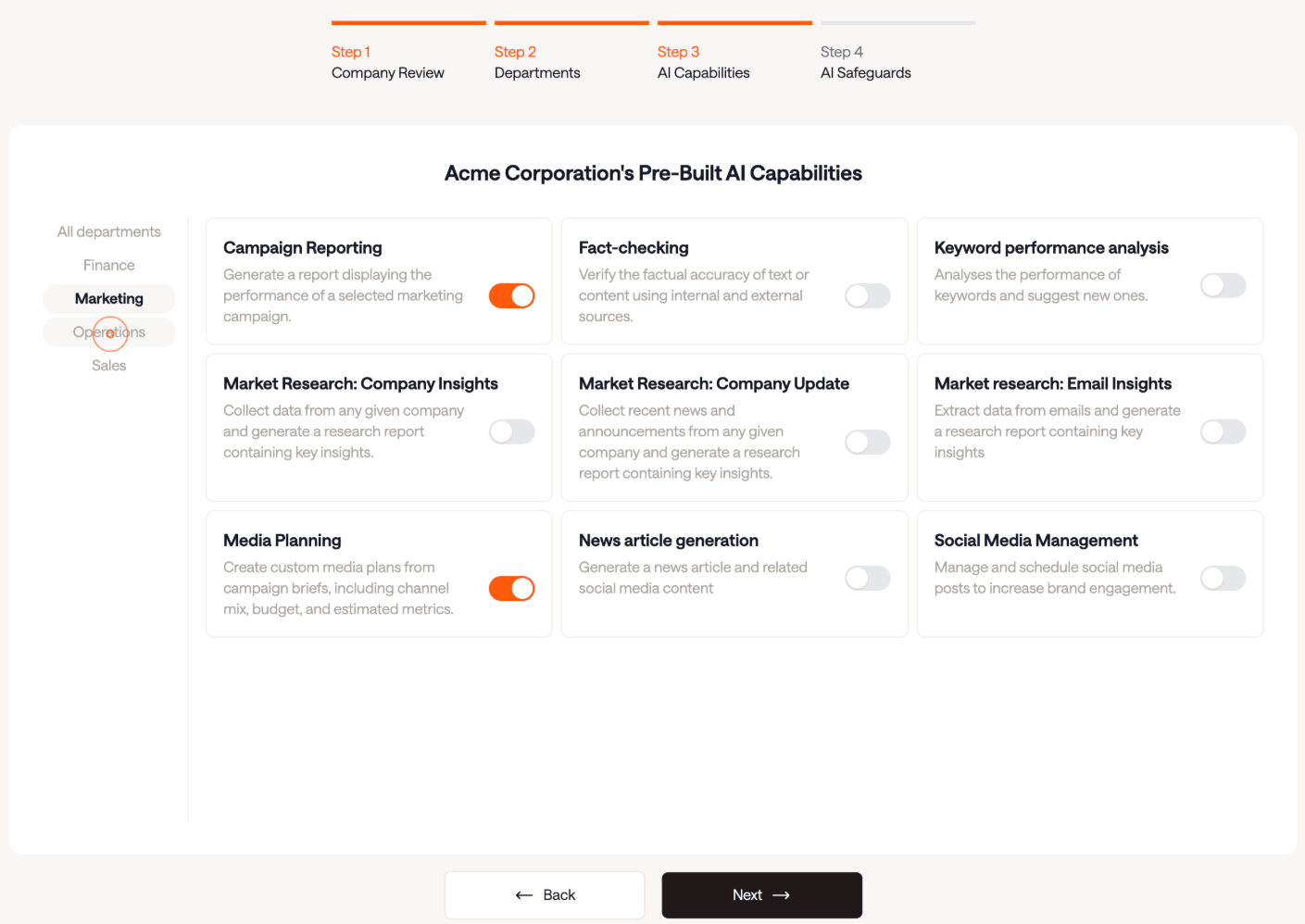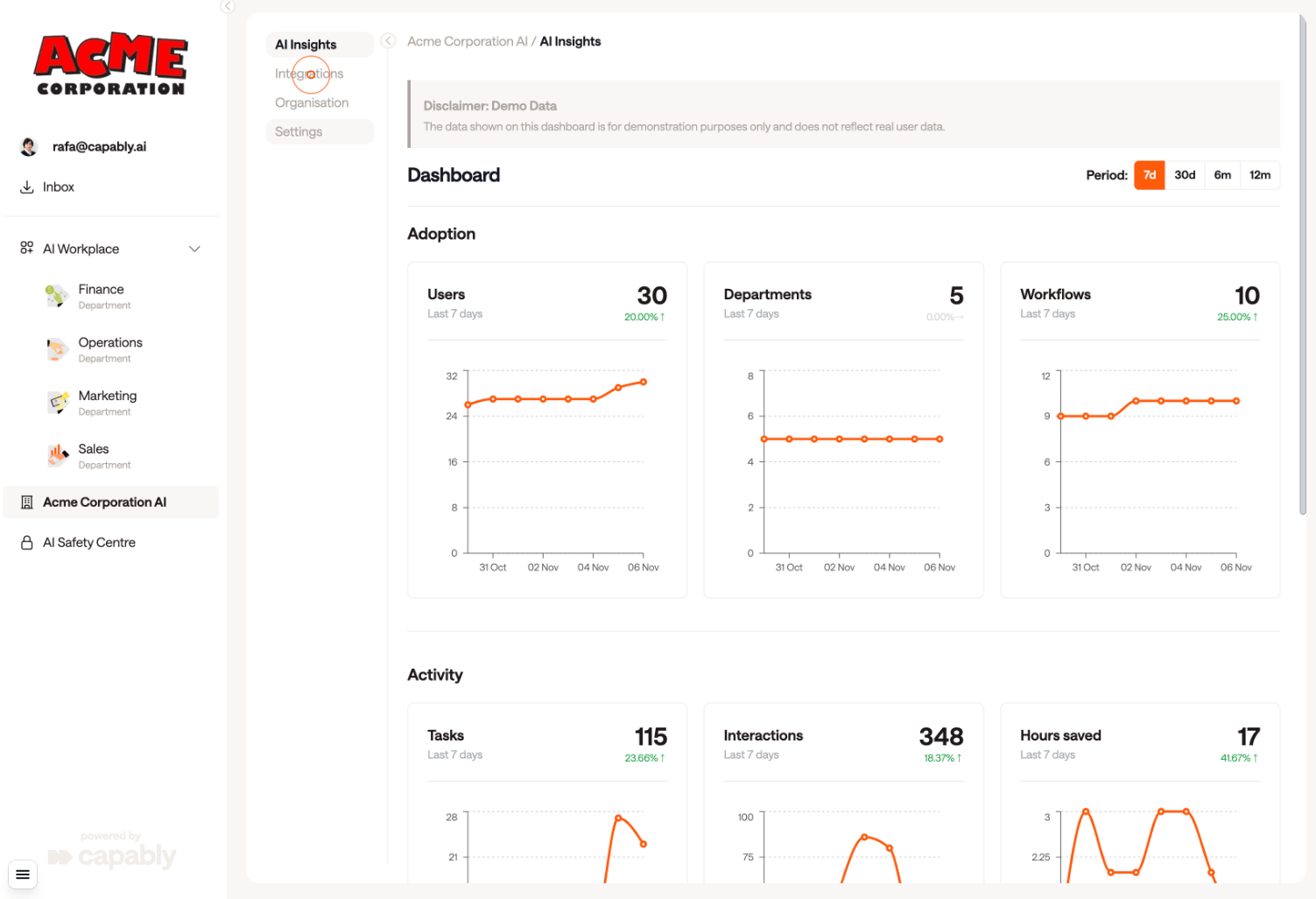How to Implement Intelligent Automation Step-by-Step

Ready to make AI actually work for your business? Here’s how to bring intelligent automation into your company, one smart step at a time.
Intelligent automation does more than speed up repetitive tasks. It changes the way work is organized and carried out. As autonomous AI systems and concepts become more common, businesses are not only improving workflows but also overall efficiency. They are also handing over complex decisions and multi-step processes to software agents that can work independently, adapt quickly, and deliver results without constant oversight.
This agentic model, in which artificial intelligence operates within context, goals, and decision-making processes, represents a significant step forward from traditional automation. The focus is not on replacing people, but on changing roles, reducing busywork, and giving teams more time for strategy, creativity, and growth.
In this intelligent automation guide, we’ll walk you through the process of moving smart automation from concept to implementation. Get ready to deep dive into a comprehensive framework designed to assess your business needs, streamline your workflows, select the perfect tools, and customize an automation model that truly aligns with your company. Whether you're launching your first autonomous agent or expanding automation across the organization, this practical playbook will enable you to harness the full potential of intelligent automation!
Understanding Intelligent Automation in the Age of Autonomous AI
Intelligent automation has evolved. What started as simple rule-based scripting (moving data, sending alerts, following predefined logic) has matured into something more capable, more adaptable, and far more autonomous.
The concepts behind autonomous AI are driving this change. These agentic systems can make their own decisions, react to new situations, and learn from what happens, all without needing instructions from people.
Unlike traditional automation, which relies on rigid instructions and breaks down when things go off-script, autonomous systems operate in context. They’re built with machine learning models and feedback loops that allow them to adapt in real time. Whether it’s rerouting a mundane task based on changing priorities or identifying anomalies in manual processes, these systems can handle complexity that static automation simply can’t.
This kind of autonomy brings three key characteristics to the table:
- Self-direction – Agents are guided by objectives, not micromanaged by rules.
- Adaptability – They can adjust to unanticipated events or changes without needing to be reprogrammed.
- Continuous learning – With each run, they get smarter, more efficient, and more aligned with business outcomes.
What makes this possible? A convergence of advanced technologies. In industrial settings, it often includes AI, cognitive computing, and robotic process automation (RPA), backed by vast data sets and the scalability of cloud infrastructure. In other business domains—especially those involving knowledge work—state-of-the-art generative AI and models like GPT-4o, Claude 3.5 Sonnet, Gemini 1.5, and Llama 3 are powering increasingly capable autonomous agents.
The barrier to entry is dropping fast. And forward-thinking companies are discovering that these systems don’t just automate tasks. They can reshape operational efficiencies and change how work gets done across the organization.
Of course, autonomy comes with trade-offs. Implementation needs to be deliberate. Safe interaction with human teams, oversight mechanisms, and cost management all matter. But when done right, intelligent agentic process automation doesn’t just execute, it evolves with your business.
How to Implement Intelligent Business Automation Step-by-Step?
If automating with autonomous AI sounds like a big leap, that’s because it is. But it doesn’t have to be a blind one. The key to a successful rollout isn’t a massive overhaul. It’s a structured, incremental approach that aligns with your business goals from day one.
In the sections that follow, we’ll walk through a practical roadmap for intelligent automation implementation: from understanding your current predefined workflows to choosing the right intelligent automation tools, customising your agentic models, and scaling with confidence. Whether you’re starting from scratch or optimizing an existing initiative, this framework will help you move from ambition to execution without the chaos.
1. Assess Business Needs and Objectives
Before diving into automation, step back and ask: What are we really trying to achieve? Leaders should pursue intelligent automation initiatives based on strategy, not novelty. That means aligning technology with real business goals and identifying the specific business challenges where autonomy can make a measurable difference.
Here’s how to focus your aim:
- Start With Strategic Objectives, Not Just Business Processes
Don’t begin by asking, “What manual tasks can we automate?” Instead, ask, “Where do we need to move faster, reduce risk, or scale better?” Ground your automation efforts in actual business priorities, whether that’s improving customer service, reducing operational costs, or increasing the accuracy of reporting to avoid costly mistakes.
- Conduct a Bottleneck Audit
Look across departments for friction points. Where are delays happening? Where do tasks pile up or get passed between too many hands? Using process mining can reveal these inefficiencies by analyzing digital footprints in your systems. Standard signals of automation opportunities include:
- High-volume, repeatable tasks
- Heavy reliance on spreadsheets or email
- Complex processes with frequent handoffs or rework
- Tasks prone to human error
Talk to the teams actually doing the work. They’ll tell you what’s broken faster than any dashboard will.
- Prioritise for Impact
Not every inefficiency needs an AI solution. Once you’ve gathered candidate processes, plot them on a simple impact-effort matrix. Focus first on high-impact, low-effort areas—these are your low-hanging fruit. Save the big, complex digital transformations for later, once you’ve built internal confidence and muscle memory.
- Define Success Metrics Early
Set clear, measurable outcomes for what “better” looks like. Is it a faster turnaround time? Fewer errors? More capacity without adding headcount? These metrics will shape your automation choices and help you prove value quickly.
🧠 Smart takeaway: Don’t look for repetitive tasks to automate. Look for outcomes to improve. Automation should solve a meaningful problem, not just check a box.
2. Map and Analyze Current Workflows
Once you know where you’re headed, it’s time to get into the mechanics of how work actually happens. You can’t automate what you don’t fully understand. Plus, most workflows are messier than they look on paper.
Here’s how to break it down:
- Document the “As-Is” Process
Map out each step of the current workflow from start to finish. This stage, often called process discovery, goes beyond the formal SOP. Talk to the people doing the work to capture what actually happens, including all the off-the-record workarounds and decision points. - Identify Breakpoints and Bottlenecks
Where do things slow down, get stuck, or go sideways? Look for manual data entry, excessive handoffs, or dependencies on specific individuals. These are your leading candidates for intelligent automation. - Surface Decision Logic
Pinpoint where human judgment is currently required. Can those decisions be standardised, or are they nuanced? Autonomous systems perform best when they have clear parameters, access to relevant data, and a feedback loop for learning over time. - Understand Data Flows
Intelligent automation thrives on data. So, look at what’s available, where it lives, and how clean or accessible it is. If your business processes rely on disconnected spreadsheets or siloed tools, solving that is often step one.
🧠 Smart takeaway: The more clearly you understand your workflows, the better you can design automation that doesn’t just replicate them, but improves them.
Choose the Right Automation Tools and Technologies
Once you’ve mapped your processes and clarified your objectives, it’s time to pick the tools that will bring your intelligent automation to life. But not all automation is created equal, and certainly not all of it is autonomous. Choosing the right technology stack comes down to understanding what level of intelligence and adaptability your business needs.
There’s a range of options in the automation ecosystem, from rules-based bots to full-fledged autonomous agents. Here’s a simplified breakdown:
- Robotic Process Automation (RPA):
Best for rule-driven manual tasks with structured data. Software robots in RPA excel at mimicking human actions in software (think: logging into systems, copying data, generating reports). But RPA is brittle. When the environment changes, bots break.
- AI-Augmented Automation:
Combines traditional RPA with artificial intelligence capabilities such as natural language processing, computer vision, and image recognition. Helpful in handling unstructured data (emails, PDFs, voice transcripts of customer engagement), performing data extractions, or making decisions within a narrow, trained domain. These are more flexible, but still operate within limits.
- Autonomous Agent Platforms:
This is where intelligent automation becomes more adaptive. These systems, often powered by large language models (LLMs), real-time data analysis, and a self-correcting loop, can take high-level objectives. Moreover, they independently carry out complex processes, coordinate tools, and make decisions based on context. It’s not just about executing steps; they’re thinking about how to accomplish a goal based on real-time inputs. That’s a game-changer for complex, cross-functional processes.
Not every business has the technical expertise, time, budget, or talent to build custom agentic systems from scratch. This is where no-code or low-code intelligent automation tools shine.
These transformative solutions, like Capably, package advanced AI capabilities—often including autonomous decision-making—into intuitive interfaces that business teams can use without writing a line of code. They’re especially valuable for:
- Fast deployment (think: weeks, not months)
- Quick learning curves
- Accessibility across all business operations, not just IT
- Built-in connectors
🧠 Smart takeaway: The most innovative automation platform isn’t the most powerful; it’s the one your team can actually use. Whether you’re building custom agent workflows or leveraging no-code platforms like Capably, the goal is the same: make autonomy practical, scalable, and aligned with how your business actually runs.
Customise Your Agentic Model
From this point forward, we’ll walk through how to actually implement an automation solution using Capably. This user-friendly, small- and medium-sized enterprise automation platform takes everything we’ve covered so far (autonomy, adaptability, accessibility). It makes it usable by anyone in your organization, not just your IT department. It’s an intelligent automation solution that helps employees hand off routine and complex tasks to AI with (literally) just a few clicks.
Let’s get started!
First of all, like any smart teammate, Capably needs to understand the business before it gets to work. That starts with training your agentic model via a guided, no-code interface that asks you for the information it needs to align with your business.
Here’s what you’ll provide:
- Company branding: So the agent acts on behalf of your company with the right look, feel, and personality.
- Tone of voice: Whether you’re formal, friendly, or somewhere in between, the agent will adapt to match.
- Company target: Who you serve, what matters to them, and how the AI should tailor its actions accordingly.
- Product offering: So the agent understands what it supports or sells.
- Current strategy: This ensures that automation stays aligned with your business goals, not just your backlog.

This setup takes minutes, not weeks. And once it’s done, your autonomous agent is ready to execute with context rather than just instructions.
🧠 Smart takeaway: An autonomous AI is only as good as the context it runs on. Train it like you would a new team member: show it who you are, what you do, and how you do it. The better it understands your business, the better it can run with it.
Start with a Pilot Project
Once your agent understands your business, the next question is: Where should it start working?
This is where many companies get stuck—trying to boil the ocean on day one. But intelligent automation doesn’t have to be an all-at-once initiative. In fact, starting small is often the smartest move. The key is choosing a pilot project with the right mix of impact and feasibility.
Think of it as the effort-value equation:
- Low effort, high value? Ideal.
- High effort, low value? Avoid.
- High effort, high value? Maybe, but save it for phase two.
- Low effort, low value? Not worth the time.
Your pilot should be big enough to matter, but not so complex as to derail momentum. Look for tasks that are repetitive, time-consuming, and rules-based but still require context or decision-making. That’s where autonomous AI shines.
Capably simplifies this by giving you a clear, structured entry point.
When setting up your pilot, the platform lets you activate one or more of 11 functional categories, each tied to real-world departmental use cases:
- Admin
- Human Resources
- Customer Support & Success
- Finance
- Insights / Analytics
- IT
- Operations
- Legal
- Marketing
- Sales
- Research & Development
For instance, automating customer onboarding workflows within the Customer Support & Success category can dramatically reduce manual data entry and improve client satisfaction from day one.

Once you select a category, Capably gives you instant access to a library of prebuilt workflow automations tailored to that business function. You don’t have to (but certainly can if necessary) build from scratch. Just choose the workflow, customize a few inputs, and you’re off.

If you are curious about the specifics, check out our practical guide on how to create agentic workflows without coding.
🧠 Smart takeaway: The best pilot projects are strategic, not symbolic. Use the effort-value lens to pick a win that delivers fast ROI, and then use it to increase automation over time. Capably does the heavy lifting by surfacing ready-made workflows you can deploy in minutes.
Scale Automation Across the Business
Once your pilot project proves its value, the next step is to scale the smart business process management. But scaling doesn’t mean unleashing automation everywhere overnight. Thoughtful, intelligent automation implementation is about intentionally expanding based on what’s working and where the most significant opportunities lie.
The good news?
If you’ve used Capably to launch your pilot, you’re already set up for scale. One of Capably’s strengths is how easy it makes it to go from “proof of concept” to “operational standard.” You don’t need to rebuild anything. You go back to the platform, activate additional categories, and apply the same agentic logic to new workflows.
Here are a few practical tips for scaling:
- Expand by function, not just volume.
If your pilot was in customer success, consider where similar logic applies—maybe operations, sales, or marketing. Capably’s modular setup lets you activate new departments one at a time, each with its own prebuilt automation templates. - Standardise what works.
Document the workflows that delivered strong results and clone the model across teams. Capably supports this with shared automation libraries and role-based access, so other departments can benefit without reinventing the wheel. - Maintain business context.
Scaling isn’t just about duplicating tasks; it’s about replicating intelligent behavior. With Capably, each expansion respects your company’s branding, tone, strategy, and audience because that context lives at the core of every agent you deploy.
🧠 Smart takeaway: Scaling isn’t about doing more. It’s about doing more of what works. With the proper foundation and a flexible platform like Capably, you can expand automation deliberately, department by department, without losing control or context.
Monitor, Optimize, and Maintain
Even the most intelligent automation doesn’t manage itself forever. Continuous monitoring is key to successful intelligent automation implementation, ensuring that agentic systems running across multiple workflows and departments remain effective and aligned with business goals.
The goal here isn’t just to make sure things don’t break—it’s to keep improving performance, increasing adoption, and aligning automation with evolving business priorities.
With Capably, this is baked into the platform. You’re not flying blind. You get a comprehensive view of how automation is functioning across your organization, including:
- Tasks completed and hours saved – So you can quantify time ROI in hard numbers, not just anecdotes.
- Workflow usage – Get more profound insights into which automations are being used (and which aren’t), and refine accordingly.
- User adoption – Track the number of active users by department or team to identify champions and laggards.
- Cross-departmental reach – See which parts of the organization are benefiting from automation and where there’s room to grow.

What makes our autonomous automation solutions especially effective here is that they track both the operational impact and the organizational engagement. That means you can measure value two ways: in actual productivity gains, and in how deeply embedded automation has become in your culture.
Here’s how to keep momentum going:
- Set regular review cycles. Automation isn’t “set it and forget it.” Build monthly or quarterly check-ins to review metrics, retire what’s not working, and double down on what’s showing huge impact.
- Gather feedback from users. Capably makes automation accessible to non-technical teams, so involve them in the improvement process. Their input provides actionable insights that help refine workflows and drive better outcomes.
- Adjust goals as you scale. The automation needs of a single department will differ from those of a company-wide rollout. Use the data Capably provides to evolve your strategy as your agentic capabilities mature.
🧠 Smart takeaway: Intelligent business process automation doesn’t end at deployment. It evolves. With built-in oversight tools like those in Capably, you can ensure your systems remain useful, relevant, and aligned with your business’s fundamental goals.
What are the Key Impacts of Intelligent Automation Implementation?
When intelligent process automation is done right, it delivers more than operational efficiency. It can shift your entire business trajectory. From cost savings to competitive agility, here are some of the most impactful benefits, backed by industry data:
1. Significant Cost Reduction
According to Deloitte Insights (2022), organizations that moved beyond piloting intelligent automation reported an average cost reduction of 32%, up from 24% in 2020; a number expected to grow as technology becomes more sophisticated and accessible. By automating high-volume tasks and enabling systems to adapt autonomously, companies can minimize manual intervention and reduce the overhead tied to exception handling, error correction, and process delays.
🧠 Smart takeaway: It’s not just about trimming costs; it’s about building smarter, self-correcting systems that reduce friction across operations.
2. Increased Productivity
Unlike traditional automation technology, which is limited by static rules and often requires human intervention, autonomous systems can scale dynamically—handling spikes in demand, rerouting tasks, and coordinating with other tools or agents on the fly. Capably’s own usage data reinforces this impact: 70% of teams report higher productivity when working alongside AI agents, while 67% of users say they save significant time on high-priority tasks (TFN, 2025).
🧠 Smart takeaway: Productivity isn’t just more output; it’s faster response times, fewer bottlenecks, and a more agile workforce.
3. Improved Accuracy and Compliance
AI-driven automation significantly reduces human error. For instance, EY’s AI fraud-detection system flagged suspicious activities that were later confirmed as fraud, demonstrating AI’s effectiveness in improving accuracy in data-heavy business processes (Forrester Consulting, 2024). Built-in audit trails and real-time monitoring also strengthen regulatory compliance efforts.
🧠 Smart takeaway: When the cost of a mistake is high, advanced automation driven by autonomous AI provides a safety net that scales.
4. Faster Decision-Making
Autonomous AI agents are designed to make informed decisions using real-time data. This means faster reactions to market changes, customer inquiries, or internal issues without waiting for human sign-off. Empirical research shows that organizations which adopt AI technologies significantly improve decision-making efficiency. For example, a +41% improvement has been reported in enterprise surveys (SecondTalent, 2025).
🧠 Smart takeaway: In fast-moving markets, reducing the time between insight and action is a competitive edge.
5. Enhanced Employee Experience
A 2021 Salesforce survey found that 89% of full-time workers are more satisfied with their jobs, and 84% are more satisfied with the companies they work for when automation frees them to focus on more meaningful work. Additionally, 91% say automation saves them time and supports a better work-life balance. This leads to higher retention, increased employee productivity, and better use of skilled talent, something that’s increasingly critical in knowledge-based roles (Salesforce, 2021).
🧠 Smart takeaway: Automation isn’t replacing people. Rather, it’s enabling them to do the work they were hired (and trained) to do.
6. Improved Customer Experience
Today’s customers expect more, and they expect it faster. In fact, 88% of service professionals say customer expectations are higher than they used to be, and 82% report that customers ask for more than ever before (Salesforce 2025). That’s not just about speed. It’s about relevance, responsiveness, and personalization.
This is where intelligent automation strategy really shines. Instead of static responses or clunky routing, autonomous agents powered by real-time data and natural language understanding can deliver tailored, helpful interactions at scale. Whether it’s document processing, resolving countless tickets, guiding a customer through a complex purchase, or proactively offering support before a problem arises, agentic automation enables businesses to meet modern expectations without burning out their human teams.
🧠 Smart takeaway: Customer relationships are the new battleground, and intelligent automation gives you the firepower to win.
6. Scalability Without the Complexity
Autonomous systems are inherently more scalable. Because they adapt without constant reprogramming, they allow businesses to grow operations or expand into new markets with less overhead. This is echoed in BCG findings, which show that digital leaders achieve 3x higher revenue growth and 3x greater cost savings from their digital transformations than laggards. In fact, they bring twice as many digital solutions to scale (Close et al., 2022).
🧠 Smart takeaway: Scaling isn’t about hiring more or buying more. It’s about building smarter systems that scale with demand.
Conclusion: From Concept to Competitive Advantage
Intelligent automation implementation isn’t just a tech upgrade. It’s a strategic shift in how modern businesses operate. The cumbersome nature of robotic process automation no longer stands in your way. Thanks to autonomous AI, the conversation has moved beyond speeding up repetitive tasks to redefining how work gets done.
As we’ve laid out, successful implementation of automation driven by autonomous artificial intelligence doesn’t start with tools. It begins with clarity: What problems are you solving? Where are the inefficiencies? What does success look like? Is it about customer experience or operational excellence? From there, it’s about identifying key opportunities for automation and choosing the right technology, that not only meets today’s needs but also scales with tomorrow’s ambitions.
When done well, autonomous AI automation doesn’t just save time or cut costs (though it does both). It unlocks capacity across the organization, empowers employees to focus on higher-value work, and creates a foundation for faster, smarter decisions.
And now, with intuitive platforms that don’t require a tech degree to operate, this kind of capability isn’t reserved for enterprises with deep engineering benches. It’s accessible, practical, and completely doable.
🧠 Final smart takeaway: Intelligent automation platforms aren’t about replacing human intelligence. They’re about giving your team the tools to do better work, at scale, with more control and less friction. And if you start right, with the right partner, scaling becomes not just possible, but inevitable.
FAQs
What is the difference between intelligent automation technologies and traditional RPA?
Traditional RPA relies on rules to complete structured tasks, but struggles with exceptions and unstructured data. Smart automation, by contrast, combines AI with automation to make decisions, adapt to new inputs, and learn over time, enabling more dynamic and scalable workflows across diverse use cases.
How do you refine automation candidates after your initial implementation?
After early wins, revisit processes that were too complex for phase one. Analyze execution data to spot bottlenecks or manual handoffs still in place. Platforms like Capably provide visibility into task patterns and outcomes, helping teams identify where automation can be deepened or expanded with minimal rework.
What success metrics should you define before implementing intelligent automation?
Standard metrics include reduction in manual hours, error rates, process cycle time, and cost savings. It’s also valuable to track softer KPIs such as employee satisfaction and capacity gains. Align metrics with business goals to measure not just efficiency, but strategic value.
How can automation initiatives avoid stagnation after the initial phase?
Sustained success requires a product mindset. Assign ownership for ongoing discovery, monitor for drift in process relevance, and continuously engage users for feedback. With platforms like Capably, organizations can evolve automation incrementally, track what works, optimize agents, and stay aligned with business needs over time.
How can organizations ensure autonomous agents stay aligned with evolving business goals?
Maintain alignment by regularly reviewing AI agent behavior, outcomes, and performance metrics. Use governance frameworks to reassess process relevance and retrain models as needed. Business and tech teams should collaborate on feedback loops to course-correct in real time.
Who should own automation governance in cross-functional teams?
Ownership varies by organization, but governance is best handled by a centralised team with input from IT, operations, compliance, and business units. Capably supports this model by offering shared visibility, role-based controls, and collaboration tools that help bridge the gap between business and technical teams.
How does intelligent automation impact employee experience and job roles?
Employees are freed from repetitive tasks, allowing them to focus on creative and strategic work. Over time, roles may evolve to include oversight of automation tools, data interpretation, or exception handling, driving upskilling and cross-functional collaboration.
Is no-code automation suitable for large enterprises, or just SMEs?
No-code AI automation tools are increasingly enterprise-ready, especially when paired with robust APIs and governance controls. They enable rapid experimentation and citizen development. However, for mission-critical or highly regulated workflow processes, a hybrid approach combining no-code with custom development often provides the best balance.